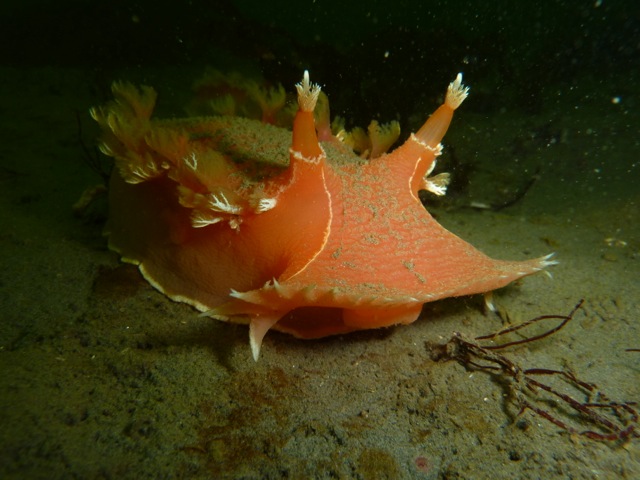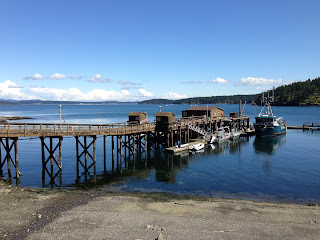Friday, May 31, 2013
Tritonia eating the soft coral sea pen Ptilosarcus
the final push
We are getting near the end of data collection and things have been going well. We have been diving 3 times a day since May 17. Fortunately, we have had no major malfunctions of equipment or divers. I've had a little free flow trouble with one regulator, but I brought a spare. We once got a line wrapped around the prop, but Russell got that sorted on snorkel. The waterproof cameras and Russell's (now vintage) Novex security video software have worked perfectly.
We've seen a porpoise, otters, eagles, osprey, and a wolf, in addition to the usual crabs, corals, slugs, and worms underwater. I plan to post some video clips next month when I have faster internet.
We are in town now on our 3-day schedule, and the co-op store opens at 830a. Then we load up and head back to the site.
We've seen a porpoise, otters, eagles, osprey, and a wolf, in addition to the usual crabs, corals, slugs, and worms underwater. I plan to post some video clips next month when I have faster internet.
We are in town now on our 3-day schedule, and the co-op store opens at 830a. Then we load up and head back to the site.
 |
| Russell taking notes floating above the video arena. |
Monday, May 27, 2013
it's not only the tropics that has colorful sea critters
gale warning
There was a gale warning, so we decided to come back to port after one night at the field site rather than sleep in the bay in a possible gale. But today was another good data day, despite 5 foot visibility.
Sunday, May 26, 2013
Saturday, May 25, 2013
Back in Tofino harbor at Fisherman's wharf after 3 days in the field. We come in around dinner time, go out to eat, come back to use the showers at the dock, grab some internet, and collapse from exhaustion. Three dives a day can be tiring. As I wrote last, the routine is to deploy the cameras, which are connected to a computer on the boat by long cables. We then set up a marker that indicates north, insert magnets in the ground, and add fluorescent markers that show us which way the water flows. We know our slug orients to water flow, especially if scented with food or mates. And we know they can use the magnetic field to guide their crawling in the lab. But we are not sure what they use the geomagnetic field for exactly. We are collected 9 hours of video of day, or more, from the six cameras each.
I'll add some more photos presently. Here is the pamphlet from Captain David McRae. He and his boat are treating us really well. David is a really likable guy, good cook, and keeps a very clean and capable boat. He's a straight up guy like some many skippers.
I'll add some more photos presently. Here is the pamphlet from Captain David McRae. He and his boat are treating us really well. David is a really likable guy, good cook, and keeps a very clean and capable boat. He's a straight up guy like some many skippers.
 |
| This is our dive site, a bay near Macintosh Rocks, near Vargas Island, BC. |
Friday, May 24, 2013
A few photos...
 |
| Sunset from Tofino |
| Russell and Jim get ready to dive off the back of the Kuroshio |
 |
| Our favorite slug out for a stroll; watch out for magnetic anomalies! |
Wednesday, May 22, 2013
first data collected
We are back in Tofino after 3 days at the field site. We spent Mon and Tues nights sleeping at the field site near Macintosh Rocks, adjacent to Vargas Island. Sunday night we spend docked at the Way West dock in Tofino after eating at the restaurant there, and getting fuel and water. Saturday night we stayed on site, and Friday May 17 we arrived in Tofino and met the skipper of the Kuroshio, David McRae, and stayed at the Fisherman's Wharf.
Saturday morning we headed off to Yellow Bank to collect some Tritonia diomedea sea slugs (now know at Tritonia tetraquetra due to a recent name change by taxonomists). We brought those slugs to nearby Macintosh Rocks because it is a more protected bay, that used to harbor this species while Dr. Wyeth did his field work in the early 2000s and when I did my field work in 1991 and 1992.
We set up underwater cameras and now have established a routine of setting cameras in the morning, rounding up slugs, adjusting cameras in the afternoon, and taking down cameras in the evening. We have had some less than stellar underwater visibility, but we have good video data for 4 days now.
We have been placing magnets in the arena monitored by video and are hypothesizing that these should lead to deviations in their expected crawling headings. We won't be able to analyze these data definitively in the field, but will be scanning them to look for early indicators. I will post some videos and photos when I have a better internet connection. Now, we are docked at Fisherman's Wharf after a nice sushi dinner and the luxury of showers and flush toilets.
Saturday morning we headed off to Yellow Bank to collect some Tritonia diomedea sea slugs (now know at Tritonia tetraquetra due to a recent name change by taxonomists). We brought those slugs to nearby Macintosh Rocks because it is a more protected bay, that used to harbor this species while Dr. Wyeth did his field work in the early 2000s and when I did my field work in 1991 and 1992.
We set up underwater cameras and now have established a routine of setting cameras in the morning, rounding up slugs, adjusting cameras in the afternoon, and taking down cameras in the evening. We have had some less than stellar underwater visibility, but we have good video data for 4 days now.
We have been placing magnets in the arena monitored by video and are hypothesizing that these should lead to deviations in their expected crawling headings. We won't be able to analyze these data definitively in the field, but will be scanning them to look for early indicators. I will post some videos and photos when I have a better internet connection. Now, we are docked at Fisherman's Wharf after a nice sushi dinner and the luxury of showers and flush toilets.
Thursday, May 16, 2013
Wednesday, May 15, 2013
Made the trip from the SF Bay Area to Friday Harbor Monday May 13th. Been digging around the labs for field gear, such as waterproof security cameras on long cables to be mounted underwater to monitor the slugs.
Planning to leave island on ferry to Sidney, BC Friday morning, May 17.
Nice view from my apartment at the Friday Harbor Labs.
Planning to leave island on ferry to Sidney, BC Friday morning, May 17.
Nice view from my apartment at the Friday Harbor Labs.
Russell Wyeth and I received a grant from the National Geographic Society's Committee for Research and Exploration to test some hypotheses about how the sea slug Tritonia diomedea uses the earth's magnetic field to navigate. We are now packing up our dive gear and lab equipment for the trip to Tofino, British Columbia, where we will board the dive boat that will be our home for three weeks. I'm leaving from my campus in Hayward, California, and Russell is starting in Antigonish, Nova Scotia. I was last at this field site in 1992.
Subscribe to:
Posts (Atom)





















